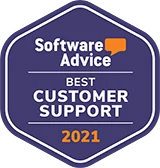With the concurrent circumstances of the world and the general convenience of digital marketing, it's to nobody's surprise that the vast majority of businesses have shifted to a predominantly online form of commerce.
Conversion rates are a vital aspect of online retailers and something every company should strive to increase. Low conversion rates indicate an ineffective marketing strategy and are often a result of unoptimized online salesmanship.
In this starter guide to eCommerce conversion rates, we'll explain everything you need to know about conversion rates, like what they are and how you calculate them, and how you can drive sales through e-commerce optimization.
What is e-commerce conversion rate optimization?
E-commerce conversion rates are calculations used by a business owner to determine the ratio of website visitors converted to buyers on their online store.
Conversion rate optimization employs various techniques and strategies to maximize the customer journey, ultimately bringing in more sales from site traffic. Therefore, it is one of the key areas for improving your customer acquisition efforts.
This process includes simplifying the checkout experience for ease of purchase, the search engine optimization of e-commerce sites, digital marketing, and many other eCommerce optimization methods.
Calculating conversion rates
To get the conversion rate, you divide the number of conversions by the number of interactions on your site.
So let's say you have 100,000 monthly visitors. Of those visitors, 5000 bought products from your site. 5000/100,000 = .05, which equates to a 5% conversion rate.
Generally, the average eCommerce conversion rate is 2.5% or below, which is average. The goal is to get an average conversion rate of 3% or more, which is reasonable conversion data.
Metrics to use for e-commerce sites
Before, we mentioned that e-commerce conversion rates could be determined by the number of interactions on your site. While this may include the number of visitors, it is not necessarily limited to this, as there are various metrics to track and consider.
Here are some different conversion rates commonly tracked by most websites in e-commerce:
Click-Through Rate
If you are running campaigns on third-party platforms, such as Facebook Ads or Google Ads, the click-through conversion rate is the number of people who click on the ad compared to the number of people who make a purchase as a result of clicking on the ad. Following this metric helps you evaluate the effectiveness of a particular campaign or a channel.
Pages Per Session
The pages per session metric is an interesting one and provides valuable insights into the visiting habits of the average customer.
The page-per-session rate gets calculated by the total number of unique page views divided by the number of sessions.
The page per session rate can help a business owner the percentage of visitors that go beyond the landing page and turn into more customers.
Bounce Rate
Opposite of the pages per session, bounce rates are conversion rates of people who enter the site through an ad or other means but then immediately leave.
A bounce rate can be determined by dividing the total number of single-page sessions by the total number of sessions overall.
Average Session Duration
The average session duration is self-explanatory; it's the average time of how long visitors spend during each session in your eCommerce store.
The average session duration helps indicate user retention and may disclose how effective the site is in keeping traffic flowing from the time they enter to the time they exit.
Exit Rate
The exit rate is the rate at which visitors exit on a specific page on a site. This metric gets determined by the number of exits divided by the number of unique views on a page.
This insight can be pretty helpful in dictating which pages are chasing potential customers away.
Likewise, if the page with the highest exit rate is a post-purchase page, then clearly, something is being done right.
For more information about the metrics to follow, check out our thorough article about e-commerce metrics.
E-commerce conversion rate optimization tips
Navigating the e-commerce world can be pretty convoluted and confusing at times, especially for someone who might be new to the digital scene and is generally inexperienced with digital marketing.
For those who aren't quite sure where to start with their marketing strategy, we've compiled this list of 12 e-commerce conversion optimization tips guaranteed for increasing eCommerce conversions and bringing in more overall retail sales:
1. Use high-quality content on your product pages
It all starts with high-quality content marketing. You can't just put "whatever" out there in place of something. Remember, every little detail matters.
If your site seems unprofessional and low-quality, visitors will be skeptical and less likely to make a purchase. This issue is because for two main reasons: first, when your content is low quality, your credibility goes down, and potential customers may perceive your site as a scam.
The other issue is that low-quality content is often an indicator of low-quality products. At least, that's how many customers will see it, and they'll end up leaving your site for competitors with a better online presence. For example, using different types of product images convey the characteristics of the product in a more comprehensive way.
There's a good chance you won't rank very high on search engines either. You can simply get more traffic by implementing high-quality images and content on your landing pages.
2. Optimize your checkout process
Checking out should be as easy as browsing. If your online shoppers are having issues checking out, your conversion rates will automatically be lower.
Not everyone is internet savvy, and having a long, complicated checkout process won't do anyone any favors. It may even hurt some businesses more than others.
For example, let's say your target demographic is an older group of people who weren't raised with the internet, and thus their internet usage/knowledge is minimal.
Since these are your main buyers, you don't want to deter them, and you should do everything in your power to enhance the customer's experience.
A good website is easy to navigate and easy to understand for everybody. There shouldn't be any "fine print" in between the lines or any overly long fluff. Just be straightforward and simple.
Luckily, Twice allows you to customize the checkout page for every product and only ask the customer to provide information that is relevant to the product in question. For example, when renting skis, more information is needed about the customer than when renting many other products.
Additionally, trust signals let customers know they are buying from a credible source and should be implemented throughout the checkout process.
This will ultimately translate into brand trust and build assurance in your company's name.
3. Offer free or discounted shipping
Another stellar way to grow the average order value is to entice more customers with something that benefits them, such as free or discounted shipping in an online store.
Since shipping is a fundamental cost of e-commerce, many people like the idea of free/discounted shipping and are more willing to make a purchase where they don't have to pay for shipping since there are no additional costs or fees.
A clever trick for your marketing campaigns is to offer free shipping while actually combining the cost of shipping within the product's price. This way, the costs are covered by the customers unbeknownst to them, and you get to charge the full price. Another option is to create a discount code that covers the delivery charges.
4. Add social proof
Social proof is your users' validation of your brand and its products. It's like when a celebrity or other well-known individual advocates and recommends a product they like to their target audience.
Social proofs are essential because they build brand trust, and they give people more incentive to buy what your business is selling.
It's more psychological than anything, as people are accustomed to finding comfort and validation in the words of others. When groups of people are praising your business's products and services, your brand's conversion rates will inevitably go up.
Adding these proofs to the home page and around product descriptions is most useful for immediately letting people know what others think.
The objective is to give visitors a cohesive list of reasons to trust your brand when they first stumble upon your eCommerce store.
5. Optimize for mobile users
The global percentage of mobile internet traffic is 59.72% daily, which is well over half of all online traffic.
And it makes sense too. People are always on the go, and smartphones dominate the communication scene. With such convenient access to the internet, of course, there's going to be a high volume of people taking advantage of this.
Since so many people are using the internet on mobile devices, optimizing your site for mobile users should be a given, as 42.3% of users will delete those if they are not optimized.
Now, this doesn't mean you necessarily have to develop an app for your business (although it might help in some cases); but it does mean making sure mobile users have ease of access when on your site. With Twice, you don't need to worry about optimizing your online store for mobile devices, as Twice does this automatically for you.
If you do everything right, then shopping online on a mobile device should be just as easy as buying from a computer (or even more manageable).
6. Use shopping cart abandonment tools
Shopping cart abandonment is when a buyer adds items to their online shopping cart but then leaves the site before making a purchase.
There could be a few reasons a customer might do this.
They might have just lost interest or found something else. There's nothing you can really do if this is the case.
There's also the chance that they may have forgotten to make the purchase or mistakenly failed to complete the checkout process.
If either of these is the case, then you might find that a shopping cart abandonment tool can help. You can do basic cart abandonment analysis even in Google Analytics, but there is also a wide range of specific conversion rate optimization tools for this job.
A shopping cart abandonment plugin will email customers who have abandoned their digital shopping carts, reminding them about the items in their cart.
This could increase conversion rates and eliminate the possibility of people forgetting to make the purchase.
7. Customers can checkout as guests
Not everyone wants to make a new account to buy a product, especially if it's their first time on the site.
That's why it's always a good idea to give customers the option of checking out as a guest. This will avoid scaring away people who are hesitant to dedicate themselves to your brand's email list and aren't sure if it's something they'll return to.
It's also for the sake of simplicity and quickness for those who need to make a last-minute purchase as soon as possible.
8. Ensure that important buttons are prevalent
This goes along with user experience best practices and making sure the website is optimized and easy to use, but we'd like to highlight this point as it's often overlooked.
Ensuring that important buttons are prevalent is vital in guiding customers to the final purchase and ensuring that they don't get lost or misguided along the way.
It also goes along with the ease-of-use functionality of your site, as people can easily navigate through your website without having to strain themselves and struggle to find where to go next.
Just remember, if the hyperlinks on your site aren't blatantly obvious, you will get higher exit conversion rates than you would like.
9. Implement progress bars
Customers can be fickle creatures. You always have to tell them where on your site they are and how much further they have to go when making a purchase.
Implementing progress bars on the bottom of the checkout screens lets people know exactly how much more they have to do and what they can expect next.
This may sound a bit unnecessary to your conversion rates, but it has its use.
For making a basic transaction on a new site, a lot of information is needed, such as billing information, account information, shipping arrangements, etc., and it can get overwhelming sometimes.
Progress bars are supplementary, quality-of-life features that avoid the "how much more do I need for this simple purchase?" state of mind and get customers on the right track to find the final phase of checking out.
10. Capture email addresses
Email marketing can be a very effective strategy to boost sales which is why you want to try to snag your customers' email addresses before they leave your eCommerce website. Once you've attained their email, you can implement them onto your email listing.
There are a great many ways you can attain a visitor's email address.
You can prompt them to sign up for a newsletter on your main page if you have a newsletter. It's a pretty direct approach and effective if you have a lot of readers.
You might also make an email address a requirement to make an account on your site. If customers have a reason to sign-up for an account or membership under your business, this is a great way to expand your email listing.
The most effective method of getting email addresses is by prompting customers who are making a purchase.
While this isn't technically necessary for billing information, few people will question why you need it.
Furthermore, the people being put on your email listing here are target customers and will be more receptive to anything you send them.
11. Your USP should be highlighted
USP stands for "unique selling proposition. It is a statement or list of proofs describing why your products are superior to the competitors.
Since the internet makes it so easy to find competitors, customers will often find themselves comparing prices and features. As a result, you need to give them a reason to buy your product instead of theirs.
12. Make sure your auto-complete fields are working
For our final tip, we recommend that you check to make sure your auto-complete fields are working.
It's a seemingly harmless function, but it can help invite impulsive buyers to your products and may deter last-minute hesitations.
The lengthy amount of time it takes to put in all the billing and shipping information may also lead to distractions which may result in a visitor being directed away from the checkout page.
In addition to supplementing conversion rates, auto-complete fields are just convenient for everyone who wants to make a purchase in your e-commerce store.
Final thoughts
When many people think of online shopping, they think of convenience and practicality.
As long as your e-commerce website supplies visitors with these two key factors, you will see higher conversion rates.
If you would still like to know more, plenty of resources are available in the form of study courses, journals, and other reputable sources.
Really, it's not that hard to increase conversion rates, just as long as you know how. With the 12 tips listed in this article, we hope that you have everything you need to know to optimize your conversion rates and get your business the recognition it deserves.








